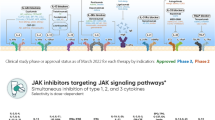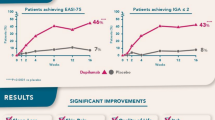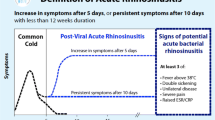Abstract
Objectives
To identify the expression of IL-33 during SLIT (Sublingual immunotherapy) in AR (Allergic rhinitis) children.
Methods
Thirty children received house dust mite (HDM) allergen extract for SLIT and thirty children received placebo in this study. Serum and nasal lavage samples of cases and controls were collected at different time points during SLIT. Interleukin (IL)-33 and other cytokines were estimated in these samples by enzyme-linked immuno sorbent assay (ELISA). Peripheral blood mononuclear cells (PBMC) were prepared and stimulated with rhIL-33 (with or without other stimulators) at different time points during SLIT.
Results
The present results showed that both serum and nasal lavage of IL-33 levels decreased significantly after 12 mo treatment and this trend maintained at least until 24 mo. The decreased nasal IL-33 level was positively correlated to local Th2 cytokines and increased IL-10 expression at 2 y post SLIT treatment. In vitro experiments showed that IL-33 promotes IL-4 and IL-5 and inhibits IL-10 expression by peripheral blood mononuclear cells (PBMCs) in AR.
Conclusions
Decreased IL-33 expression during SLIT may contribute to low Th2 response and enhanced Regulatory T cell cytokines expression. Thus, IL-33 maybe an important predictor during SLIT.



Similar content being viewed by others
References
Strachan D, Sibbald B, Weiland S, et al. Worldwide variations in prevalence of symptoms of allergic rhinoconjunctivitis in children: the international study of asthma and allergies in childhood (ISAAC). Pediatr Allergy Immunol. 1997;8:161–76.
Björkstén B, Clayton T, Ellwood P, Stewart A, Strachan D; ISAAC Phase III Study Group. Worldwide time trends for symptoms of rhinitis and conjunctivitis: phase III of the international study of asthma and allergies in childhood. Pediatr Allergy Immunol. 2008;19:110–24.
Hamouda S, Karila C, Connault T, Scheinmann P, de Blic J. Allergic rhinitis in children with asthma: a questionnaire-based study. Clin Exp Allergy. 2008;38:761–6.
Golden DBK. Stinging insect vaccines: patient selection and administration of hymenoptera venom immunotherapy. Immunol Allergy Clin N Am. 2000;20:553–70.
Wilson AB, Deighton J, Lachmann PJ, Ewan PW. A comparative study of IgG subclass antibody in patient allergic to wasp or bee venom. Allergy. 1994;49:272–80.
Kurowska-Stolarska M, Hueber A, Stolarski B, McInnes IB. Interleukin-33: a novel mediator with a role in distinct disease pathologies. J Intern Med. 2011;269:29–35.
Kearley J, Buckland KF, Mathie SA, Lloyd CM. Resolution of allergic inflammation and airway hyperreactivity is dependent upon disruption of the T1/ST2-IL-33 pathway. Am J Respir Crit Care Med. 2009;179:772–81.
Asaka D, Yoshikawa M, Nakayama T, Yoshimura T, Moriyama H, Otori N. Elevated levels of interleukin-33 in the nasal secretions of patients with allergic rhinitis. Int Arch Allergy Immunol. 2012;158:47–50.
Glück J, Rymarczyk B, Rogala B. Serum IL-33 but not ST2 level is elevated in intermittent allergic rhinitis and is a marker of the disease severity. Inflamm Res. 2012;61:547–50.
Haenuki Y, Matsushita K, Futatsugi-Yumikura S, et al. A critical role of IL-33 in experimental allergic rhinitis. J Allergy Clin Immunol. 2012;130:184–94.e11.
Luo R, Liu W, Wang J, et al. Role of BAFF in pediatric patients with allergic rhinitis during sublingual immunotherapy. Eur J Pediatr. 2014;173:1033–40.
Wang C, Wang K, Liu S, Qin X, Chen K, Zhang T. Decreased level of osteopontin in children with allergic rhinitis during sublingual immunotherapy. Int J Pediatr Otorhinolaryngol. 2016;81:15–20.
Valovirta E, Jacobsen L, Ljorring C, Koivikko A, Savolainen J. Clinical efficacy and safety of sublingual immunotherapy with tree pollen extract in children. Allergy. 2006;61:1177–83.
Irander K, Palm JP, Borres MP, Ghafouri B. Clara cell protein in nasal lavage fluid and nasal nitric oxide-biomarkers with anti-inflammatory properties in allergic rhinitis. Clin Mol Allergy. 2012;10:4.
Alvarez-Cuesta E, Bousquet J, Canonica GW, Durham SR, Malling H-J, Valovirta E; EAACI, Immunotherapy Task Force. Standards for practical allergen-specific immunotherapy. Allergy. 2006;61:1–20.
Frew AJ. Sublingual immunotherapy. N Engl J Med. 2008;358:2259–64.
Park IH, Hong SM, Lee HM. Efficacy and safety of sublingual immunotherapy in Asian children. Int J Pediatr Otorhinolaryngol. 2012;76:1761–6.
Yonekura S, Okamoto Y, Sakurai D, et al. Sublingual immunotherapy with house dust extract for house dust-mite allergic rhinitis in children. Allergol Int. 2010;59:381–8.
Miller AM. Role of IL-33 in inflammation and disease. J Inflamm. 2011;8:22.
Liu X, Li M, Wu Y, Zhou Y, Zeng L, Huang T. Anti-IL-33 antibody treatment inhibits airway inflammation in a murine model of allergic asthma. Biochem Biophys Res Commun. 2009;386:181–5.
Coyle AJ, Lloyd C, Tian J, et al. Crucial role of the interleukin 1 receptor family member T1/ST2 in T helper cell type 2-mediated lung mucosal immune responses. J Exp Med. 1999;190:895–902.
Kondo Y, Yoshimoto T, Yasuda K, et al. Administration of IL-33 induces airway hyperresponsiveness and goblet cell hyperplasia in the lungs in the absence of adaptive immune system. Int Immunol. 2008;20:791–800.
Karakoc GB, Yilmaz M, Altıntaş DU, Kendirli SG. Can serum-specific IgE/total IgE ratio predict clinical response to allergen-specific immunotherapy in children monosensitized to house dust mite? J Allergy (Cairo). 2012;2012:694094.
Ohashi Y, Nakai Y, Tanaka A, et al. The clinical role of specific IgE and IgG4 antibodies in patients having immunotherapy for seasonal allergic rhinitis. Clin Otolaryngol Allied Sci. 1998;23:128–35.
Author information
Authors and Affiliations
Contributions
YW, CL, YX conceptualized and designed the study, drafted the initial manuscript, and approved the final manuscript as submitted. DX, GY, FL, XL performed the experiments, coordinated and supervised data collection, reviewed and revised the manuscript, and approved the final manuscript as submitted. CL will act as guarantor for this paper.
Corresponding author
Ethics declarations
Ethical Approval
All procedures performed in studies involving human participants were in accordance with the ethical standards of the institutional and/or national research committee and with the 1964 Helsinki declaration and its later amendments or comparable ethical standards.
Conflict of Interest
None.
Rights and permissions
About this article
Cite this article
Wang, Y., Li, C., Xu, Y. et al. Sublingual Immunotherapy Decreases Expression of Interleukin-33 in Children with Allergic Rhinitis. Indian J Pediatr 85, 872–876 (2018). https://doi.org/10.1007/s12098-018-2703-3
Received:
Accepted:
Published:
Issue Date:
DOI: https://doi.org/10.1007/s12098-018-2703-3




